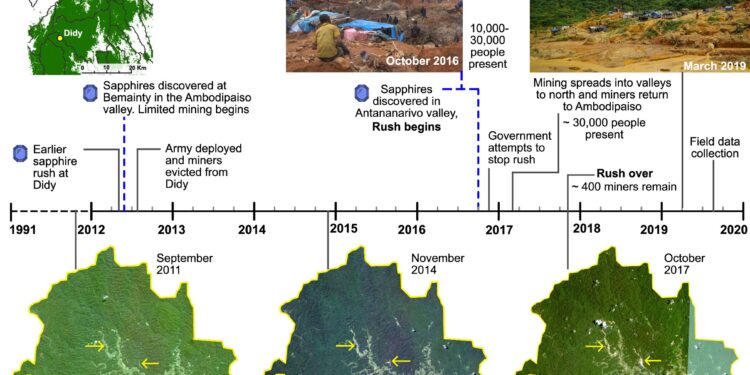Timeline of mining development in the Bemainty catchment during the study period. Credit: Earth and Environment Communications (2024). DOI: 10.1038/s43247-024-01655-6
If tens of thousands of miners showed up in the middle of a protected rainforest to mine sapphires, it could be expected to cause widespread deforestation and harm local wildlife.
Mining has a very bad reputation. It is often considered one of the worst uses of land: it destroys and pollutes the environment and creates arid, moon-like landscapes. When mining takes place in areas with high biodiversity, it is considered a serious threat.
But in the rainforests of eastern Madagascar, more than 10,000 people mining sapphires have done no more damage to the forest than farmers clearing land for agriculture, which remains the main driver of deforestation in this region.
My recent research, published in Earth and Environment Communicationsfocuses on quantifying the effects of sapphire mining on Madagascar’s forests. My findings challenge some preconceptions about the impacts of small-scale mining. I show that, although attention-grabbing, some forms of mining can be surprisingly low-impact and less damaging than other land uses.
In October 2016, a valuable sapphire deposit was discovered by gold prospectors in the protected rainforests of the Ankeniheny-Zahamena corridor in eastern Madagascar. These rainforests are very important for biodiversity as they are home to many unique species at risk of extinction, including lemurs such as the indri and the black and white crested emur. News of the sapphire’s discovery spread quickly. Within weeks, tens of thousands of people from across the island were illegally logging the Bemainty Valley, deep in the forest.
Miners used shovels to dig pits between 1 and 3 meters deep in the valley floor to extract river sediments. They used handmade sieves and stream water to sift sediment and search for gemstones. The work was hard, living conditions in the hastily constructed settlements were poor, and the rewards uncertain.
The unlucky miners left the site poorer than they were when they arrived. Some became rich, while others earned enough money to survive and perhaps save a little more to invest in education, land, or businesses. This type of mining, called artisanal and small-scale mining, is not unique to Madagascar. It is widespread and supports around 40 million people worldwide.
The mining rush at Bemainty attracted international media attention due to fears over its environmental impacts, with reports that it was causing significant deforestation and threatening endangered lemur populations. This has caused serious concern among environmental advocates.
My research aimed to assess claims of deforestation. To properly assess the impact of something, an essential step is to estimate what would have happened without it: the counterfactual. To roughly calculate the extent of deforestation in Bemainty without mining, my colleagues and I used the average area of deforestation within a set of control forest areas, chosen to be as similar as possible to Bemainty but, importantly, without mining. We then compared deforestation in Bemainty to this counterfactual.
We found that mining at Bemainty did not cause more deforestation than we estimate might have happened anyway from other causes. In this region, the main driver of deforestation is shifting cultivation, where people cut and burn patches of forest on the slopes to grow rice for a few years on a rotation cycle. We showed that more than 10,000 people working in mining in the region caused no more deforestation than several hundred people clearing forest for agriculture. The impacts of the artisanal gem rush must be considered in this broader context.
The limited negative effects of mining on deforestation in Bemainty could be explained by several reasons. First, sapphires were found in river sediments, limiting mining to the valley floor.
Second, much of this area had been cleared for agricultural purposes decades before, when the first settlers arrived. Third, miners did not use heavy machinery and sapphire mining does not use toxic chemicals (like mercury used in gold mining).
The variability of small-scale mining
More broadly, these results highlight that the environmental impacts of artisanal mining vary greatly. They depend on the scale, methods, machinery and chemicals used, as well as the environmental impact of alternative land uses that people might otherwise make, such as farming or cutting down trees to make charcoal. Although in some areas artisanal and small-scale mining causes major environmental problems, where mining is small-scale and does not use heavy machinery or chemicals, the environmental effects can be just as limited.
However, in many countries, this variability is not taken into account in policies favoring artisanal mining. Policies tend to focus on criminalizing or stopping artisanal mining, but often have little effect. I think these universal policies are heavily influenced by negative preconceptions about mining and worst-case scenarios, and not necessarily by specific evidence, which is lacking in many countries.
We must stop treating all mining activities the same way. Artisanal mining provides income to millions of poor people around the world who, despite the challenges, decide it is their best – and perhaps only – option. Given its importance, policymakers need to rethink their preconceptions. Where mining has a low environmental impact, more open and flexible policies are needed to regulate it in ways that balance the needs of poor communities and the conservation of biodiversity.
More information:
Katie Devenish et al, No evidence of increased forest loss from a rush for mining in eastern Madagascar’s rainforests, Earth and Environment Communications (2024). DOI: 10.1038/s43247-024-01655-6
Provided by The Conversation
This article is republished from The Conversation under a Creative Commons license. Read the original article.
Quote: Madagascar’s mining rush hasn’t caused more deforestation than agriculture, study finds (2024, October 1) retrieved October 1, 2024 from
This document is subject to copyright. Except for fair use for private study or research purposes, no part may be reproduced without written permission. The content is provided for informational purposes only.



